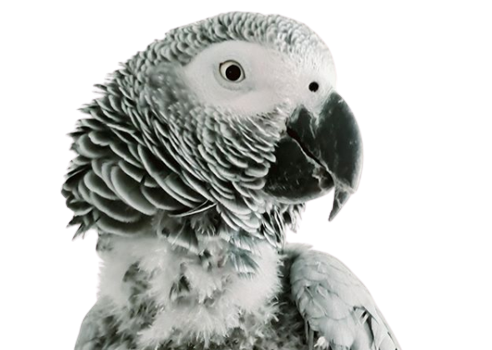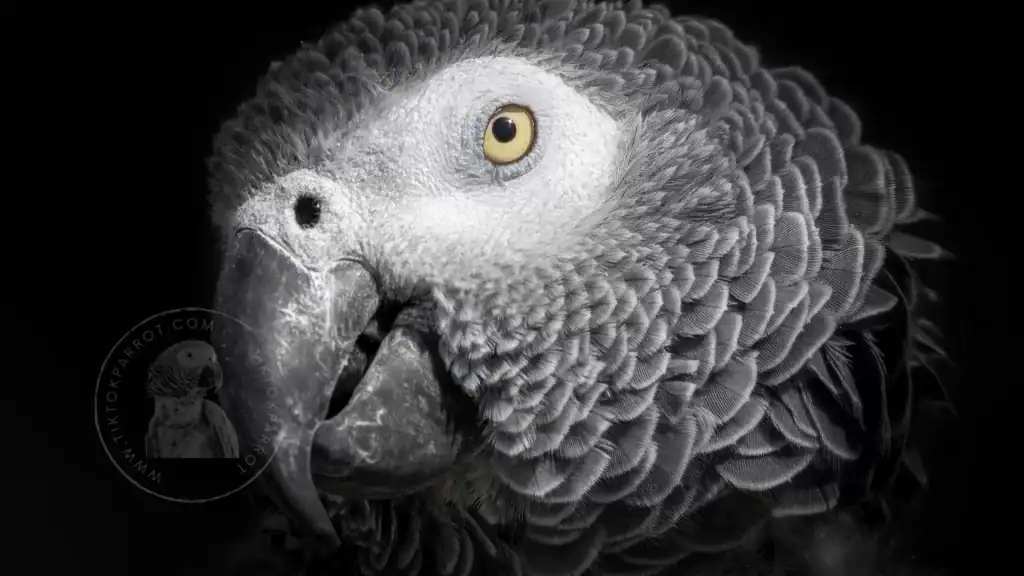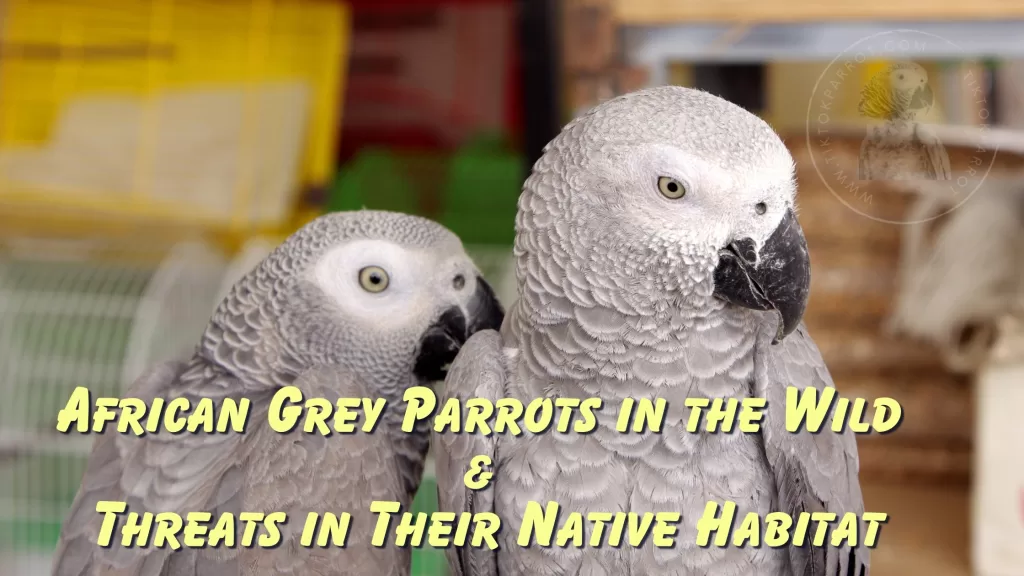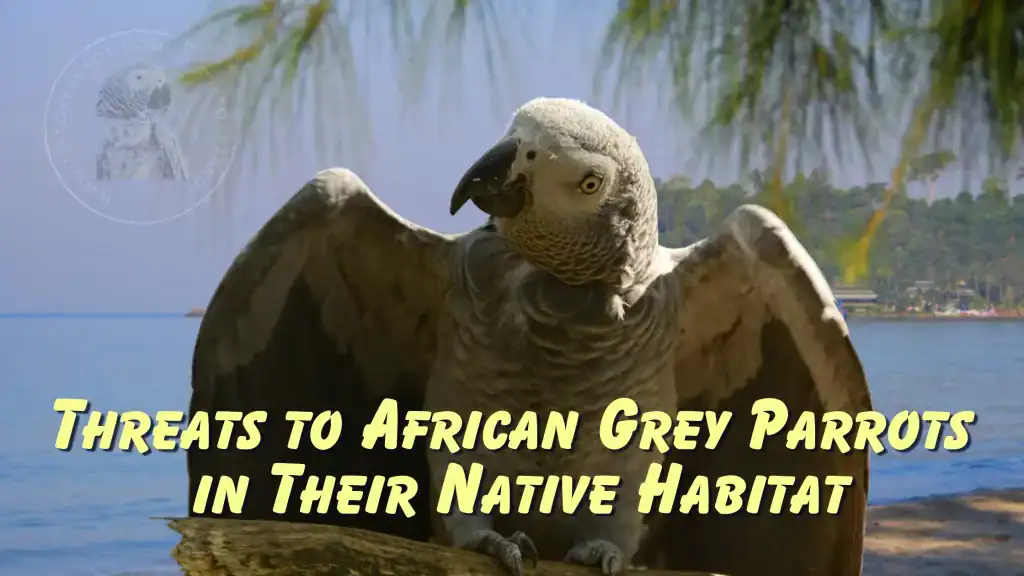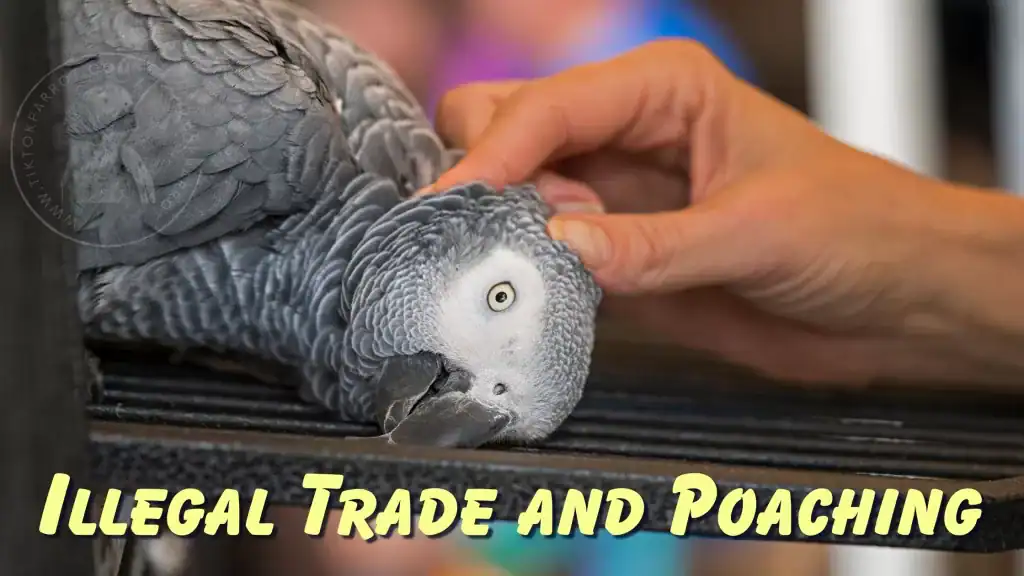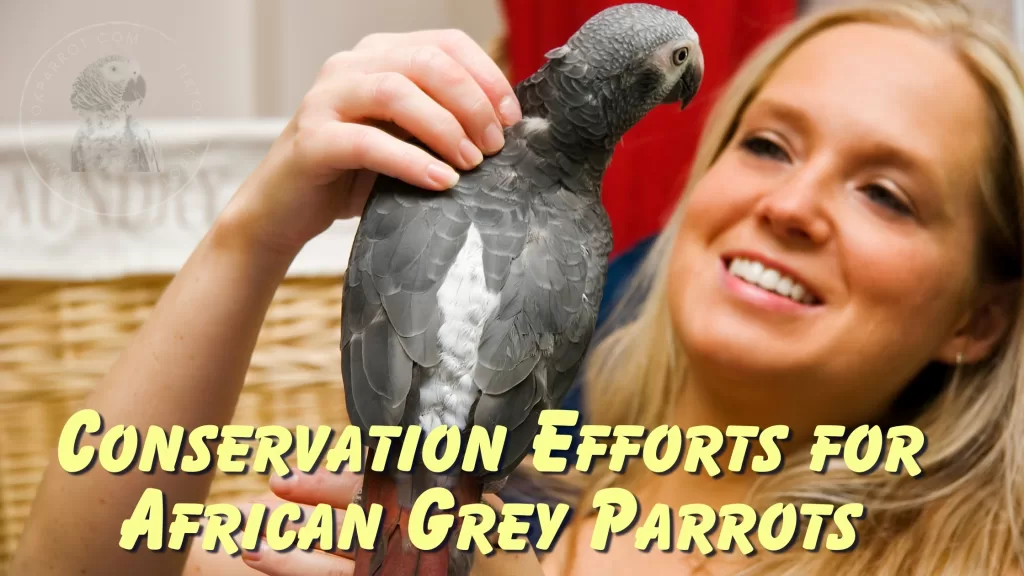Unfortunately, the population of African grey parrots in the wild is declining rapidly due to habitat loss and poaching. These birds are highly intelligent and have been known to exhibit problem-solving abilities and social cognition. They are also popular as pets due to their ability to mimic human speech and their affectionate personalities.
However, the thriving population of these birds in the wild is at risk due to various threats that their native habitats face. In this article, we will discuss the African grey parrots in the wild, their behaviors, characteristics, and the threats they face in their native habitat.
Learn about the conservation efforts being made to protect African grey parrots in the wild and the threats they face in their native habitat. Discover what you can do to help protect these intelligent and beautiful birds.
Below also we will explore the conservation efforts being made to protect African grey parrots in the wild and the threats they face in their native habitat.
Introduction
African grey parrots are native to several countries in Africa, including Cameroon, Congo, Ghana, and Ivory Coast. They inhabit dense forests and woodland areas, where they can be found feeding on fruits, nuts, seeds, and insects.
These parrots are scientifically known as Psittacus erithacus, are one of the most intelligent and captivating birds found in the wild. Native to the rainforests of West and Central Africa, these parrots are known for their exceptional mimicking ability, high intelligence, and social skills.
The demand for African grey parrots as pets has led to a significant decline in their population in the wild. The illegal trade of these birds is estimated to have reduced their numbers by up to 90% in some areas. Poachers use inhumane methods to capture these birds, such as trapping them in nets or snaring them, which often leads to injury or death.
Characteristics and Behaviors
African grey parrots are medium-sized birds that can grow up to 33 centimeters in length and weigh between 400 to 650 grams. These birds are primarily known for their exceptional mimicry ability and high intelligence. Greys are also incredibly social birds that love to interact with others of their kind and their human caretakers.
One of the unique behaviors of African grey parrots is their tendency to form monogamous relationships with their partners, which can last for years. These birds also display a high level of affection and loyalty towards their partners and human caretakers.
Habitat of African Grey Parrots
African Grey Parrots are native to the dense rainforests of West and Central Africa. These birds are typically found in the canopies of these forests, where they build their nests in tree hollows. Grey Parrots are also known to inhabit savannas, agricultural lands, and coastal mangroves.
The natural habitats of African grey parrots are characterized by high humidity, rainfall, and diverse vegetation. These habitats provide these birds with a variety of food sources, including fruits, seeds, nuts, and flowers.
Conservation Efforts:
Conservation organizations are working to protect African grey parrots in the wild through various initiatives. These include creating protected areas and enforcing laws against poaching and illegal trade. They are also working to educate the public about the importance of these birds and their role in the ecosystem.
- Protected Areas:
Protected areas are established to safeguard natural habitats and their inhabitants. Grey parrots are found in many protected areas, including national parks and wildlife reserves. These areas help to preserve the birds’ natural habitat and protect them from human encroachment.
- Law Enforcement:
Illegal poaching and trade of Grey parrots are major threats to their survival in the wild. Many countries have implemented laws and regulations to protect these birds and their habitats. Law enforcement agencies work to enforce these laws and prevent the illegal trade of these parrots.
- Education:
Educating the public about the importance of grey parrots in the wild is crucial for their conservation. Many conservation organizations and educational institutions are working to raise awareness about the threats facing these birds and the steps that can be taken to protect them.
I will explain further below in the blog about the conservation efforts which are being made, first let’s discuss the threats which African grey parrots are facing in their native habitat.
Threats to African Grey Parrots in Their Native Habitat
Despite their adaptability and intelligence, African grey parrots in the wild face numerous threats to their survival. Some of the most significant threats to these birds include:
Habitat Loss and Fragmentation
The destruction of forests due to agricultural expansion, mining, logging, and urbanization has led to the fragmentation and loss of natural habitats of grey parrots. As a result, these birds are forced to move into suboptimal habitats or risk extinction.
African grey parrots depend on forest habitats for their survival, but deforestation and habitat destruction are major threats to their survival. As forests are cleared for agriculture, logging, and human settlement, the birds lose their nesting and feeding grounds, which can lead to their decline in numbers.
The destruction of the natural habitat of African grey parrots is one of the biggest threats to their survival. Deforestation, logging, and agricultural expansion are the main drivers of habitat destruction in Africa. This destruction has led to a significant decline in the number of grey parrots in the wild.
Impact of habitat destruction
Habitat destruction affects African grey parrots in several ways. The destruction of their natural habitat reduces the availability of food, nesting sites, and roosting areas. It also exposes them to predators and human activities such as hunting and illegal trade.
Illegal Trade and Poaching
African grey parrots are highly valued for their intelligence, social skills, and mimicry ability, making them a prime target for illegal trade and poaching. The demand for these birds as pets has led to the capture and transportation of thousands of greys from the wild, further threatening their survival.
The illegal trade of grey parrots is a lucrative business that poses a significant threat to their survival. The demand for these birds as pets has led to a massive decline in their population in the wild. The trade in grey parrots is driven by several factors, including their intelligence, beauty, and ability to mimic human speech.
Impact of illegal trade
The illegal trade in African grey parrots has several negative impacts on their survival. The trapping of these birds for the pet trade disrupts their natural social structure, reduces their genetic diversity, and increases the risk of disease transmission. Additionally, the illegal trade in grey parrots fuels corruption and organized crime.
These parrots are highly sought after as pets due to their intelligence and ability to mimic human speech. However, capturing and trading these birds is illegal and can lead to their decline in numbers. Poachers often use cruel and inhumane methods to capture these birds, which can cause harm or death.
Hunting
Hunting of African grey parrots for food and cultural practices is another major threat to their survival. In some African countries, the hunting of these birds is legal, while in others, it is illegal. Regardless of its legality, hunting grey parrots has contributed to the decline in their population in the wild.
Impact of hunting
The hunting of African grey parrots has several negative impacts on their survival. It reduces the population of these birds, disrupts their natural social structure, and reduces their genetic diversity. Additionally, the hunting of grey parrots can have a negative impact on the ecosystems where they live.
Climate Change
Climate change has led to changes in rainfall patterns, increasing the risk of droughts and wildfires in the habitats of grey parrots. These changes have led to the loss of food sources and nesting sites for these birds, further threatening their survival.
Climate change is another threat to the survival of grey parrots. Changes in weather patterns can affect the availability of food and water, and extreme weather events can damage habitats and cause population declines.
Conservation Efforts for African Grey Parrots
Efforts to conserve African grey parrots in the wild are ongoing, and various organizations are working to address the threats these birds face. Some of the conservation efforts include:
Habitat Restoration and Protection
Efforts are underway to restore and protect the natural habitats of African grey parrots. These efforts involve reforestation, protection of forests, and the creation of wildlife reserves to ensure the survival of these birds.
Education and Awareness
Conservation organizations are educating local communities on the importance of conserving African grey parrots and the threats these birds face. These efforts aim to reduce the demand for these birds as pets and prevent the poaching and illegal trade of these parrots.
Education campaigns aim to raise awareness about the importance of protecting grey parrots in their native habitat. This includes public outreach programs, educational materials, and media campaigns.
Legal Protection & Law enforcement
Several countries have enacted laws to protect African grey parrots from illegal trade and poaching. For example, the African grey parrot is listed on Appendix II of the Convention on International Trade in Endangered Species of Wild Fauna and Flora (CITES), which means that the international trade of these birds is regulated and monitored.
Many countries in Africa have also enacted laws to protect African grey parrots. In Cameroon, for example, it is illegal to capture, kill, or trade African grey parrots without a permit. In the Democratic Republic of Congo, it is illegal to export African grey parrots without a CITES export permit.
However, enforcing these laws can be challenging, and illegal trade and poaching of grey parrots continue to occur. It is essential for governments to work together with conservation organizations and local communities to enforce these laws and prevent the illegal trade and poaching of these parrots.
In addition to legal protection, it is also essential to address the root causes of illegal trade and poaching, such as poverty, lack of education, and the high demand for these birds as pets. By addressing these underlying issues, we can work towards long-term solutions that protect African grey parrots and their habitats.
Law enforcement efforts aim to reduce the illegal trade and hunting of grey parrots. This includes the enforcement of national and international laws, the confiscation of illegally traded birds, and the prosecution of wildlife traffickers.
What you can do?
If you are interested in helping to protect African grey parrots in the wild, there are several things you can do. You can support conservation organizations that work to protect these birds and their habitats. You can also avoid buying grey parrots as pets and report any illegal trade or poaching activity to law enforcement.
Before I jump to my final thoughts, here are some of the frequently asked questions about African grey parrots;
FAQs (frequently asked questions)
Q: Why are African Grey Parrots endangered?
A: African grey parrots are endangered due to habitat loss and poaching for the illegal pet trade.
Q: How many African grey parrots are left in the wild?
A: The population of African grey parrots in the wild is difficult to estimate accurately, but it is believed that their numbers have significantly declined, and they are now listed as endangered due to habitat loss, poaching for the pet trade, and other threats.
Q: What can I do to help protect African Grey Parrots in the wild?
A: You can support conservation organizations that work to protect these birds and their habitats. You can also avoid buying greys as pets and report any illegal trade or poaching activity to law enforcement.
Q: Where can I see African Grey Parrots in the wild?
A: African grey parrots are found in several countries in Africa, including Cameroon, Congo, and Ghana. Many national parks and wildlife reserves offer opportunities to see these birds in their natural habitat.
Q: How long do African Grey Parrots live?
A: African Grey Parrots have a long lifespan and can live between 50-60 years or even up to 80 years in captivity if looked after well. In the wild, their lifespan is shorter, ranging from 15-30 years.
Q: why African grey parrots live a shorter life in the wild?
A: African grey parrots in the wild have shorter lifespans due to a combination of factors such as predation, disease, and habitat destruction, as compared to their captive counterparts.
Q: How can habitat loss be prevented?
A: Habitat loss can be prevented by implementing sustainable land-use practices and protecting natural habitats. This can include reforestation, agroforestry, and conservation programs that work to preserve natural habitats and wildlife.
Q: What are the breeding habits of African Grey Parrots?
A: African Grey Parrots are monogamous and mate for life. They typically breed in the rainy season when food is abundant, and females lay 2-4 eggs in a clutch. Both parents share incubation duties and care for the young.
Q: How can I identify an African Grey Parrot in the wild?
A: African Grey Parrots have a distinctive grey plumage with a white mask around their eyes. They also have a bright red tail and a black beak. Their wingspan can reach up to 20 inches, making them one of the larger parrot species.
Q: Where do African grey parrots sleep in the wild?
A: African grey parrots in the wild typically sleep in tree cavities, where they can roost and protect themselves from predators.
Q: What do African grey parrots eat in the wild?
A: African grey parrots in the wild primarily feed on a varied diet of fruits, seeds, nuts, and vegetation, as well as occasional insects and snails for protein.
Q: What is the role of African Grey Parrots in their ecosystem?
A: African Grey Parrots play an important role in their ecosystem as seed dispersers. They feed on fruits and nuts and spread seeds throughout the forest, which helps to maintain a healthy ecosystem. They also provide a source of food for predators such as snakes and raptors.
Q: How many species of African Grey Parrots are there?
A: There are two recognized species of African grey parrots: the Congo African Grey Parrot and the Timneh African Grey Parrot.
Q: Are African Grey Parrots endangered?
A: Yes, African grey parrots are classified as endangered by the International Union for Conservation of Nature (IUCN) due to habitat loss and illegal trade.
Q: How can I help support the conservation of African Grey Parrots?
A: You can support the conservation of African grey parrots by donating to reputable conservation organizations, raising awareness about the threats facing these birds, and avoiding the purchase of grey parrots as pets. You can also participate in ecotourism activities that support the conservation of these birds and their habitats.
Q: Can African Grey Parrots be trained to speak?
A: Yes, African grey parrots are highly intelligent and can be trained to mimic human speech and other sounds. They are one of the most popular parrot species kept as pets due to their ability to learn and repeat words and phrases. You can see my Mitthu known as (TiktokParrot) could speak four languages, complete words and phrases, but sad he did not live a longer life.
Q: How do African Grey Parrots communicate with each other?
A: African grey parrots communicate with each other through a variety of vocalizations, including calls, whistles, and squawks. They can also use body language and facial expressions to convey meaning.
Q: What is the scientific name for African Grey Parrots?
A: The scientific name for the Congo African Grey Parrot is Psittacus erithacus, while the scientific name for the Timneh African Grey Parrot is Psittacus timneh.
Q: What is the average size of an African Grey Parrot?
A: African grey parrots can reach up to 12-14 inches in length and can weigh between 12-18 ounces.
Q: What is the natural range of African Grey Parrots?
A: African grey parrots are native to several countries in Africa, including Cameroon, Congo, Ghana, and Ivory Coast. They inhabit dense forests and woodland areas.
Q: What is the diet of African Grey Parrots?
A: African grey parrots primarily feed on fruits, nuts, seeds, and insects in the wild. In captivity, their diet can include a variety of fruits, vegetables, and pellets formulated specifically for parrots.
Q: Are African Grey Parrots social animals?
A: Yes, African grey parrots are highly social animals and live in flocks in the wild. They communicate with each other through a variety of vocalizations and engage in grooming and other social behaviors.
Q: What is the current population of African Grey Parrots in the wild?
A: The exact population of African grey parrots in the wild is unknown, but they are considered to be declining rapidly due to habitat loss and poaching.
Q: What is the impact of the illegal pet trade on African Grey Parrots?
A: The illegal pet trade has had a devastating impact on the population of African grey parrots in the wild. Poachers often use cruel and inhumane methods to capture these birds, which can cause injury or death. In addition, the trade of these birds as pets has led to a decline in their numbers in the wild.
Q: What are some of the challenges faced by conservation organizations working to protect African Grey Parrots?
A: Conservation organizations working to protect African grey parrots face several challenges, including limited resources, political instability in some regions, and the difficulty of enforcing laws and regulations against poaching and illegal trade.
Q: What is the role of ecotourism in the conservation of African Grey Parrots?
A: Ecotourism can play a role in the conservation of African grey parrots by providing financial support for conservation initiatives and raising awareness about the importance of these birds and their habitats. Ecotourism activities can also provide an alternative source of income for local communities, reducing the dependence on poaching and illegal trade.
Q: What are some of the long-term goals of African Grey Parrot conservation efforts?
A: The long-term goals of African grey parrot conservation efforts include increasing the population of these birds in the wild, protecting their natural habitats, and reducing the demand for them as pets. Conservation organizations are also working to raise awareness about the importance of these birds and their role in the ecosystem.
Q: How do African Grey Parrots contribute to the ecosystem?
A: African grey parrots play an important role in their ecosystem as seed dispersers. They feed on fruits and nuts and spread seeds throughout the forest, which helps to maintain a healthy ecosystem. They also provide a source of food for predators such as snakes and raptors.
Q: What is the main cause of habitat loss for African Grey Parrots?
A: Habitat loss for African grey parrots is primarily caused by deforestation and habitat destruction due to human activities such as logging, agriculture, and human settlement.
Q: What is the role of education in African Grey Parrot conservation efforts?
A: Education is an important component of African grey parrot conservation efforts as it helps to raise awareness about the importance of these birds and their conservation needs. Conservation organizations are working to educate the public about the threats facing grey parrots and the steps that can be taken to protect them.
Q: What is the impact of climate change on African Grey Parrots?
A: Climate change can impact the survival of African grey parrots by affecting the availability of food and water, and causing extreme weather events that can damage habitats and lead to population declines.
Q: Are there any captive breeding programs for African Grey Parrots?
A: Yes, there are captive breeding programs for African grey parrots in some countries. These programs aim to increase the population of these birds and reduce the dependence on capturing them from the wild.
My Final Thoughts
African grey parrots are intelligent and beautiful birds that are facing significant threats in their native habitat. Conservation efforts, including protected areas, law enforcement, and education, are being made to protect these birds and their habitats.
However, continued efforts are needed to ensure the survival of grey parrots in the wild. By supporting conservation organizations and avoiding the illegal trade of these birds, we can all play a role in protecting these amazing creatures for future generations.
If you found this blog helpful, It would be great if you could share it with your family and friends who might find it useful as well.
You might like to read these as well
Understanding of Grey Parrot’s Body Language
African Grey Parrot Male or Female? (Determine Gender of African Grey)
Is Your African Grey a Jealous Bird? Here’s What You Need to Know!
African Grey Parrots: The Ultimate Guide to Care and Training
Unlock the Secrets of Choosing the Perfect African Grey Parrot
The Importance of a Cage for Your African Grey Parrot
For more useful content about African grey parrots, you can subscribe my site with your email to get notification upon publishing a new blog, the subscribe box you can see on the right side of this page. Also if you get an alert on your web browser while browsing my site, allow it and that will also give you an alert whenever I publish a new blog.
Stay safe and much love !


